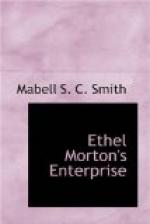“He must be a convict at hard labor,” guessed Roger.
“Or the Mayor of the Prairie Dog Town setting an example to his constituents,” laughed James.
The polar bear was suffering from the heat and nothing but the tip of his nose and his eyes were to be seen above the water of his tank where he floated luxuriously in company with two cakes of ice.
The wolves and the foxes had dens among rocks and the wild goats stood daintily on pinnacles to see what was going on at a distance. No one cared much for the reptiles, but the high flying cage for birds kept them beside it for a long time.
Across the road they entered the grounds of the Arboretum and passed along a narrow path beside a noisy brook under heavy trees, until they came to a grove of tall hemlocks. With upturned heads they admired these giants of the forest and then passed on to view other trees from many climes and countries.
“Here’s the Lumholtz pine that father wrote me about from Mexico,” cried Ethel Blue, whose father, Captain Morton, had been with General Funston at Vera Cruz. “See, the needles hang down like a spray, just as he said. You know the wood has a peculiar resonance and the Mexicans make musical instruments of it.”
“It’s a graceful pine,” approved Ethel Brown. “What a lot of pines there are.”
“We are so accustomed about here to white pines that the other kinds seem strange, but in the South there are several kinds,” contributed Dorothy. “The needles of the long leaf pine are a foot long and much coarser than these white pine needles. Don’t you remember, I made some baskets out of them?”
The Ethels did remember.
“Their green is yellower. The tree is full of resin and it makes the finest kind of kindling.”
“Is that what the negroes call ’light wood’?” asked Della.
“Yes, that’s light wood. In the fields that haven’t been cultivated for a long time there spring up what they call in the South ’old field pines’ or ‘loblolly pines.’ They have coarse yellow green needles, too, but they aren’t as long as the others. There are three needles in the bunch.”
“Don’t all the pines have three needles in the bunch?” asked Margaret.
“Look at this white pine,” she said, pulling down a bunch off a tree they were passing. “It has five; and the ‘Table Mountain pine’ has only two.”
“Observant little Dorothy!” exclaimed Roger.
“O, I know more than that,” laughed Dorothy. “Look hard at this white pine needle; do you see, it has three sides, two of them white and one green? The loblolly needle has only two sides, though the under is so curved that it looks like two; and the ‘Table Mountain’ has two sides.”
“What’s the use of remembering all that?” demanded Mary sullenly.
Dorothy, who had been dimpling amusedly as she delivered her lecture, flushed deeply.
“I don’t know,” she admitted.




